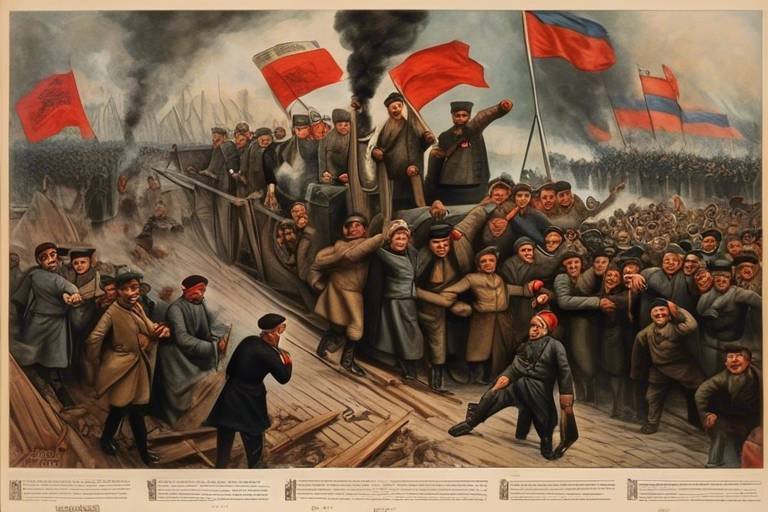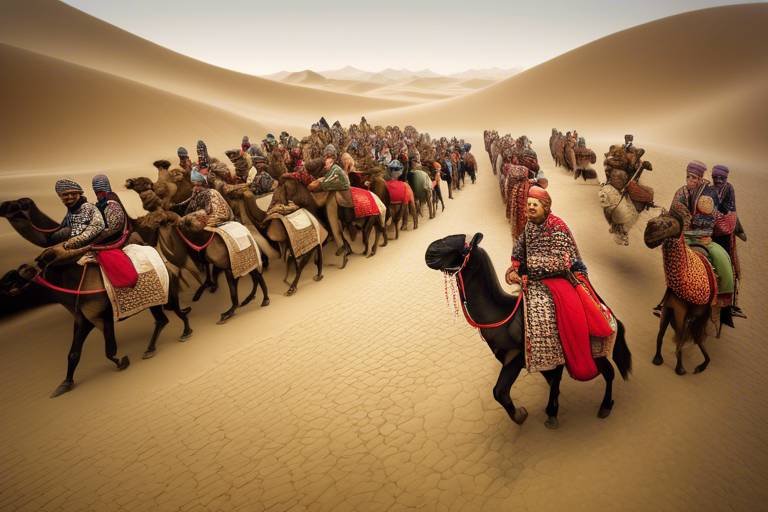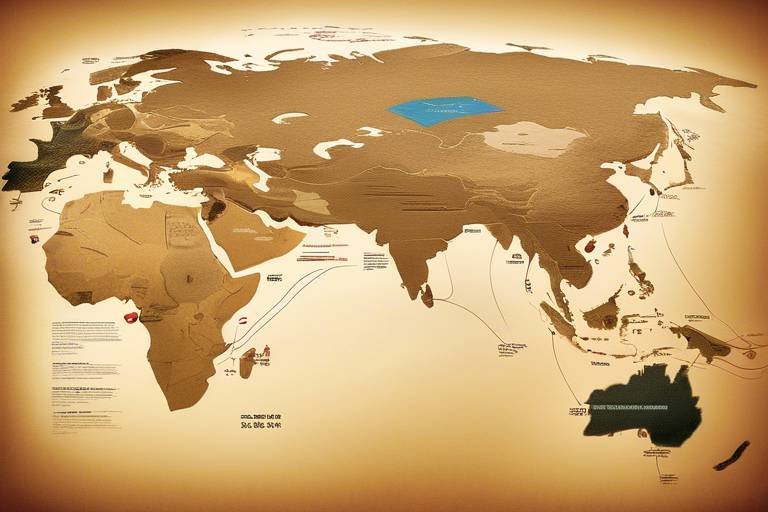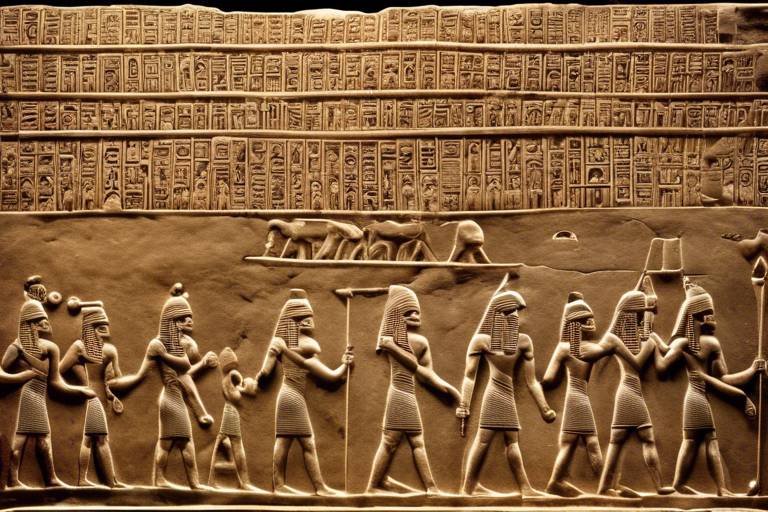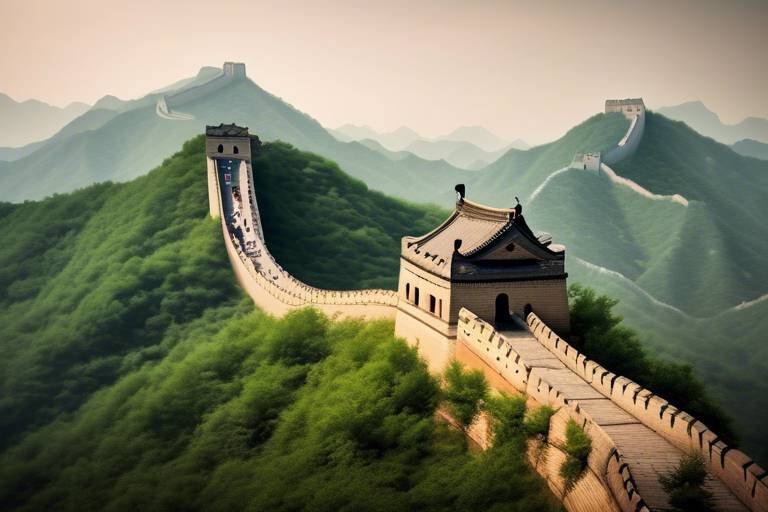The Role of Geography in Historical Events
Geography is not merely a subject confined to maps and coordinates; it is a dynamic force that has shaped the course of history in profound ways. From determining the outcomes of wars to influencing cultural exchange and economic systems, geographical factors have played a pivotal role in shaping significant historical events.
When we delve into the impact of terrain on warfare, we uncover a rich tapestry of how mountains, rivers, and forests have served as strategic elements in battles and wars throughout history. The topography of the land has often decided the fate of empires and civilizations, showcasing the intricate dance between geography and conflict.
Moreover, the establishment of trade routes enabled by geographical features has not only facilitated economic growth but also fostered cultural exchange and the spread of ideas. These routes acted as arteries through which goods, knowledge, and beliefs flowed, connecting distant lands and shaping the identities of societies.
Colonial expansion, driven by the quest for access to natural resources, stands as a testament to how geography has influenced global power dynamics and economic structures. The scramble for territories rich in minerals, fertile lands, and other resources has redrawn maps and redefined the balance of power on a global scale.
Examining the impact of climate change on civilization collapse reveals a sobering truth about the vulnerability of societies to environmental shifts. Throughout history, changes in climate patterns have triggered the downfall of once-great civilizations, underscoring the interconnectedness between nature and human societies.
Geopolitical borders, often demarcated by geographical features such as rivers and mountain ranges, have been both a product of and a source of conflict between nations. The struggle to control strategic territories and resources has fueled tensions and shaped the course of diplomacy and warfare.
Human migration patterns, influenced by geographical factors such as climate, resources, and natural barriers, have led to the establishment of settlements and the development of societies. The movement of people across landscapes has not only shaped demographics but also contributed to the rich tapestry of human history.
Coastal regions have served as gateways to exploration, enabling civilizations to embark on maritime trade and discovery. The vast expanse of the sea has beckoned adventurers and traders, fostering cross-cultural interactions and expanding the horizons of human knowledge and influence.
Furthermore, the impact of geographical constraints on urbanization patterns, city planning, and infrastructure development highlights the intricate dance between human ingenuity and natural boundaries. Cities have risen and fallen in response to the challenges posed by the land, showcasing the resilience and adaptability of human societies.

Impact of Terrain on Warfare
When we delve into the annals of history, one cannot help but notice the profound impact that terrain has had on the outcomes of wars and battles. Terrain features such as mountains, rivers, and forests have not merely been passive spectators but active participants in shaping the course of warfare.
Imagine a scenario where an army must traverse through rugged mountain ranges to reach its enemy. The steep slopes, narrow passes, and unpredictable weather conditions all pose formidable challenges, turning the very landscape into an adversary. In such terrain, the element of surprise can be a double-edged sword, offering both strategic advantages and vulnerabilities.
Similarly, rivers have served as natural barriers, dividing armies and dictating the flow of battle. Crossing a river under enemy fire requires meticulous planning and often determines the outcome of skirmishes. The strategic positioning of forces along riverbanks can either provide a defensive stronghold or expose vulnerabilities to flanking maneuvers.
Forests, with their dense foliage and uneven terrain, have provided cover for guerrilla warfare and ambush tactics throughout history. The ability to navigate through dense forests, maintain supply lines, and communicate effectively in such environments has been a decisive factor in many conflicts.
Moreover, the interaction between different terrain types, such as a mountain range leading to a river, can create strategic chokepoints that shape the battlefield. Understanding how to leverage these natural features, whether by fortifying key positions or exploiting vulnerabilities, has been a hallmark of successful military commanders.
In essence, terrain is not merely a backdrop but a dynamic force that has influenced the strategies, tactics, and outcomes of warfare. It underscores the importance of adaptability, resourcefulness, and a deep understanding of the geographical context in which conflicts unfold.

Trade Routes and Cultural Exchange
Trade routes have served as the arteries of cultural exchange throughout history, intertwining societies and enabling the flow of goods, ideas, and people across vast distances. The Silk Road, for example, connected the East and West, fostering trade between civilizations and facilitating the exchange of silk, spices, and technologies. This network of ancient trade routes not only boosted economic growth but also sparked cultural diffusion, as merchants, scholars, and travelers traversed diverse terrains, encountering new customs and beliefs along the way.
Geographical features played a pivotal role in shaping these trade routes, with mountain passes, rivers, and deserts dictating the paths that traders could traverse. The rugged terrain of the Himalayas, for instance, posed challenges to travelers but also offered strategic vantage points for establishing trade hubs and settlements. Similarly, the navigable waters of the Mediterranean Sea provided a maritime highway for civilizations such as the Phoenicians and Greeks to engage in commerce and cultural interactions.
The exchange of goods along these trade routes not only fueled economic prosperity but also facilitated the transmission of knowledge and ideas. The ancient city of Alexandria, situated at the crossroads of trade between Europe, Africa, and Asia, became a melting pot of cultures, where scholars from diverse backgrounds shared insights on mathematics, astronomy, and philosophy. This intellectual cross-pollination laid the foundation for scientific advancements and philosophical debates that reverberated across continents.
Moreover, the interconnectivity fostered by trade routes transcended mere economic transactions, leading to the blending of artistic styles, architectural techniques, and culinary traditions. The Silk Road, for instance, witnessed the exchange of silk textiles from China, spices from India, and glassware from the Roman Empire, creating a vibrant tapestry of cultural influences that enriched the artistic expressions of each region. This cultural fusion not only enriched local traditions but also laid the groundwork for future artistic movements and design innovations.
In essence, trade routes served as conduits of cultural exchange, weaving a complex web of interactions that transcended borders and united distant civilizations in a shared tapestry of human experience. The legacy of these ancient trade networks continues to resonate in the modern world, reminding us of the transformative power of exchange and cooperation across geographical divides.

Colonial Expansion and Natural Resources
Exploring how geographical factors have influenced and shaped significant historical events throughout time.
Terrain features such as mountains, rivers, and forests have played crucial roles in determining the outcomes of battles and wars.
The establishment of trade routes, facilitated by geographical features, has led to cultural exchange, economic growth, and the spread of ideas.
Geographical factors like access to natural resources have driven colonial expansion, shaping global power dynamics and economic systems. The abundance or scarcity of resources such as minerals, fertile land, and water sources have been key drivers behind the exploration and colonization of new territories. For example, European powers sought to establish colonies in regions rich in resources like gold, spices, and timber, leading to the exploitation of these lands and the establishment of trade networks that shaped the course of history.
Examining how shifts in climate patterns have contributed to the collapse of civilizations throughout history.
The formation of geopolitical borders based on geographical features has often been a source of conflict and tension between nations.
Geography has influenced human migration patterns, leading to the establishment of settlements and the development of societies.
Coastal regions have played a significant role in the exploration and expansion of civilizations, enabling maritime trade and discovery.
The impact of geographical constraints on urbanization patterns, city planning, and infrastructure development throughout history.

Climate Change and Civilization Collapse
Climate change has been a significant factor in the collapse of civilizations throughout history. The impact of shifting climate patterns on societies has been profound, leading to widespread disruptions in food production, water availability, and overall living conditions. In many cases, prolonged droughts, severe floods, or unpredictable weather patterns have contributed to the downfall of once-thriving civilizations.
For example, the decline of the ancient Mayan civilization in Mesoamerica has been linked to a series of prolonged droughts that affected agricultural productivity and led to social unrest. The inability to adapt to changing climatic conditions ultimately contributed to the collapse of this advanced society.
Similarly, the fall of the Akkadian Empire in Mesopotamia around 2200 BCE has been attributed, in part, to a shift towards drier conditions that impacted agricultural yields and strained resources. The inability to sustain the empire under changing climate conditions eventually led to its demise.
Climate change has not only affected individual civilizations but has also had broader implications for global history. The Little Ice Age, a period of cooling temperatures between the 14th and 19th centuries, had far-reaching consequences, including crop failures, famine, and social upheaval in various parts of the world.
Understanding the historical relationship between climate change and civilization collapse is crucial in addressing the contemporary challenges posed by global warming and environmental degradation. By learning from past mistakes and recognizing the vulnerability of societies to climatic shifts, we can better prepare for the future and strive to build more resilient and sustainable civilizations.

Geopolitical Borders and Conflict
Geopolitical borders, drawn based on geographical features, have been a breeding ground for conflict and tension between nations throughout history. The demarcation of boundaries, often influenced by natural landmarks like rivers, mountains, and coastlines, has been a source of territorial disputes and power struggles. These borders, while serving to define sovereign territories, have also been points of contention, leading to wars, diplomatic standoffs, and political unrest.

Migration Patterns and Settlements
Migration patterns have been deeply influenced by geographical factors throughout history. The natural landscape, such as mountains, deserts, and bodies of water, has acted as both barriers and facilitators for human movement. For instance, the Himalayas have long served as a formidable barrier between the Indian subcontinent and Central Asia, shaping migration routes and cultural exchanges. In contrast, the Nile River in ancient Egypt not only provided fertile land for settlements but also acted as a natural highway for trade and migration.
Moreover, the availability of resources and favorable climates in certain regions has attracted migrants, leading to the establishment of settlements and the rise of civilizations. The Mesopotamian region, with its fertile soil and access to water from the Tigris and Euphrates rivers, witnessed the development of some of the earliest known urban centers. Similarly, the Mediterranean climate and natural harbors in ancient Greece encouraged seafaring and the establishment of coastal settlements that became hubs of trade and cultural exchange.
Migration patterns have not only shaped the distribution of populations but also influenced the cultural diversity and social structures of societies. The movement of people across different regions has resulted in the blending of traditions, languages, and technologies, contributing to the richness of human civilization. The Silk Road, a network of trade routes connecting the East and West, facilitated the exchange of goods, ideas, and beliefs, leading to the development of diverse cultures along its path.
Furthermore, conflicts and environmental changes have often forced populations to migrate in search of safer or more hospitable lands. The Great Migration of the 20th century in the United States, driven by economic opportunities and escaping racial segregation, reshaped urban demographics and cultural landscapes. Similarly, the displacement of communities due to natural disasters or political upheavals has highlighted the vulnerability of settlements to external forces and the resilience of human populations in adapting to new environments.

Impact of Coastal Regions on Exploration
Coastal regions have always been at the forefront of exploration and expansion throughout history. The proximity to the sea has provided civilizations with access to maritime trade routes, enabling them to venture into the unknown and discover new lands. The vast expanse of the ocean has acted as a gateway to uncharted territories, fostering a spirit of adventure and curiosity among explorers.
Moreover, coastal regions have served as strategic hubs for trade and cultural exchange, allowing different civilizations to interact and share knowledge. The abundance of resources found in coastal areas, such as fish and fertile land, has attracted settlers and facilitated the growth of coastal communities. This symbiotic relationship between humans and the sea has fueled exploration and expansion, shaping the course of history.
Furthermore, the navigational advantages offered by coastal regions have been instrumental in the development of maritime technologies and exploration techniques. Ancient seafaring civilizations like the Phoenicians and the Vikings utilized coastal waters to navigate vast distances, establishing trade networks that spanned continents. The exploration of coastal regions has not only expanded geographical knowledge but also connected distant lands, fostering cultural exchange and economic growth.
In addition, the strategic importance of coastal regions in military conquests and territorial expansion cannot be overlooked. Many empires throughout history have sought to control key coastal territories to gain access to valuable resources and establish dominance over trade routes. The exploration and colonization of coastal regions have shaped the geopolitical landscape, leading to the rise and fall of powerful civilizations.
Overall, the impact of coastal regions on exploration has been profound, influencing the course of history and shaping the development of human societies. From ancient seafarers to modern-day explorers, coastal regions continue to inspire curiosity and drive the quest for discovery in the endless expanse of the sea.

Urbanization and Geographic Constraints
Urbanization, the process of population concentration in cities, has been greatly influenced by geographic constraints throughout history. When we look at the development of cities, we can see how geographical factors have shaped their growth and layout. Imagine a city nestled between steep mountains, limiting its expansion and forcing the construction of narrow, winding streets. These geographic constraints not only affect the physical layout of the city but also impact infrastructure development and accessibility.
For instance, cities located in coastal areas have often faced challenges in urban planning due to the proximity to water bodies. The need to balance development with environmental conservation in coastal regions has led to innovative solutions in city design. Coastal cities have had to adapt to rising sea levels and natural disasters, leading to the implementation of sustainable urban development practices.
Geographical features such as rivers and lakes have also played a significant role in shaping urbanization patterns. Cities built along major waterways have historically thrived due to access to transportation routes for trade and commerce. However, these same water bodies can pose challenges during times of flooding or drought, influencing the resilience of urban infrastructure.
Moreover, the availability of resources and arable land has dictated the location and growth of cities throughout history. Cities situated in fertile regions have flourished, while those in arid areas have had to innovate to ensure sustainability. Geographical constraints such as limited space for expansion or natural barriers like deserts have forced urban planners to think creatively in developing infrastructure and housing solutions.
In conclusion, urbanization and geographic constraints are intricately linked, with the physical environment playing a crucial role in shaping the development of cities. By understanding the impact of geography on urban growth, we can better appreciate the unique challenges and opportunities that different regions face in building sustainable and resilient urban centers.
Frequently Asked Questions
- How has geography influenced historical events?
Geography has played a significant role in shaping historical events by impacting warfare strategies, trade routes, colonial expansion, climate patterns, migration, exploration, urbanization, and more. It has influenced the outcomes of battles, the spread of cultures, the rise and fall of civilizations, and the development of societies.
- What is the relationship between terrain and warfare?
Terrain features such as mountains, rivers, and forests have influenced warfare tactics and outcomes throughout history. They have provided natural defenses, strategic advantages, or obstacles that have determined the success or failure of military campaigns.
- How have trade routes impacted cultural exchange?
Trade routes, enabled by geographical features like rivers and seas, have facilitated the exchange of goods, ideas, and technologies between different regions and civilizations. This exchange has fostered cultural diversity, economic growth, and the spread of knowledge.
- Why is access to natural resources crucial for colonial expansion?
Access to natural resources such as minerals, fertile land, and water sources has been a driving force behind colonial expansion. Control over these resources has shaped the power dynamics between nations, influenced economic systems, and fueled conflicts.
- How has climate change affected civilizations?
Changes in climate patterns, such as droughts, floods, or shifts in temperature, have contributed to the collapse of civilizations by disrupting agricultural practices, causing food shortages, and triggering social unrest. Climate has been a significant factor in the rise and fall of ancient societies.







